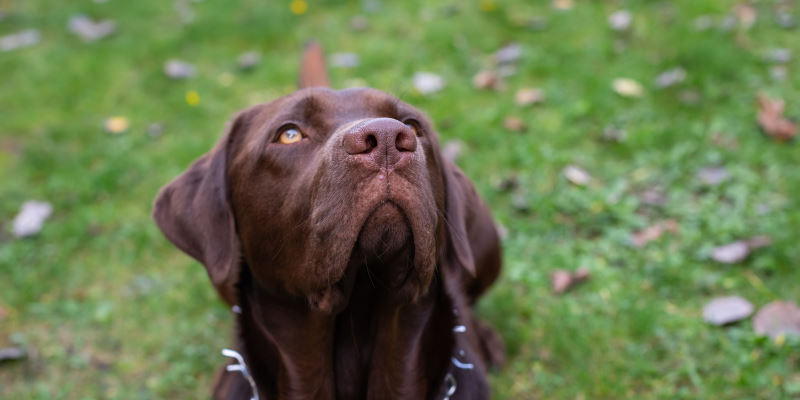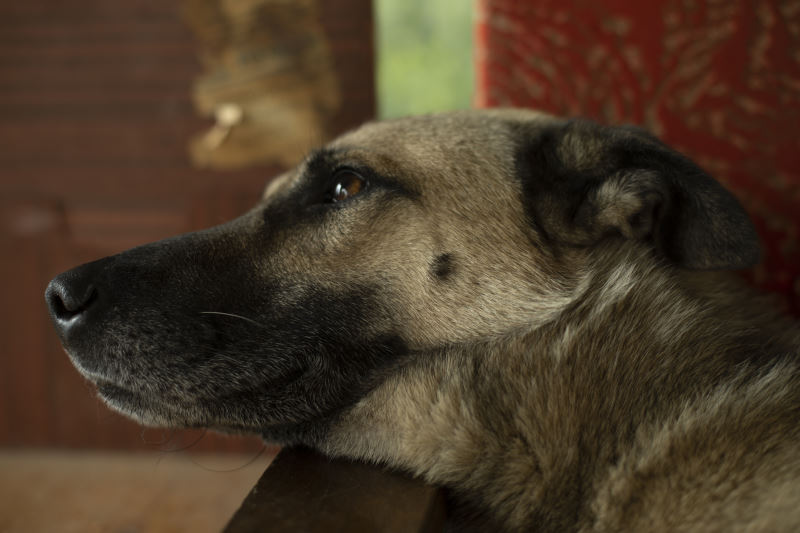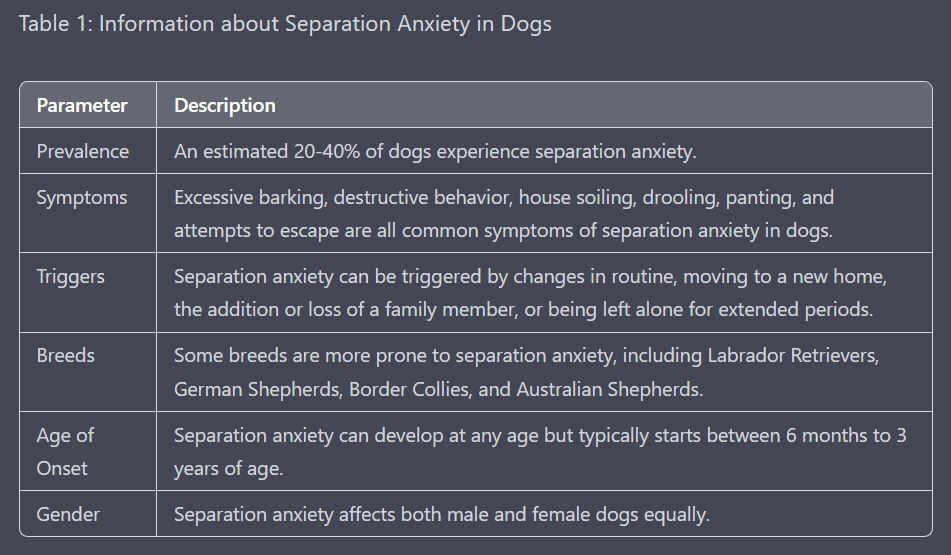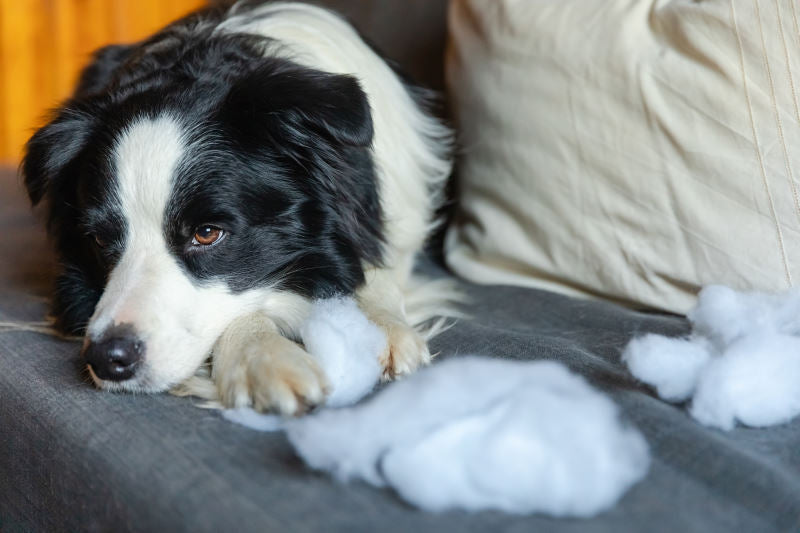Observing one’s beloved pet experience separation anxiety can be a deeply distressing experience. Leaving an anxious canine companion behind can be a challenging task, regardless of whether you are embarking on a brief errand or a lengthy workday. Thankfully, there are measures that can be taken to assist canines in managing separation anxiety and guaranteeing their sense of security and ease during periods of absence. This guide aims to investigate the etiology and clinical manifestations of separation anxiety in canines, as well as provide pragmatic approaches for identifying and alleviating your dog’s anxiety. This article will discuss various tools and strategies that can be employed to assist anxious dogs in overcoming their fears and developing confidence during periods of separation. These techniques include positive reinforcement training and the creation of a secure environment for the animal.
This article delves into the topic of separation anxiety in dogs, exploring its underlying causes, observable symptoms, and potential effects on the animal’s well-being.
Canine separation anxiety presents a complex challenge for both the pet and its caregiver. The presence of certain stimuli may result in notable levels of stress and anxiety for canines, which may subsequently lead to detrimental consequences such as harm to personal property or injury to the dog. It is imperative to identify the indications of separation anxiety in dogs to administer efficacious intervention and assistance for your four-legged companion.
Excessive barking or whining is a commonly observed indicator of separation anxiety in canines. Canines that suffer from separation anxiety may express their discomfort through vocalization when they are left unaccompanied frequently and persistently. Canine individuals may resort to detrimental activities, such as gnawing on household items or excavating the ground, as a means of managing their anxious state. In instances of heightened severity, canines may resort to self-injury as a means of extricating themselves from confinement.
The etiology of separation anxiety in canines remains incompletely comprehended, but it is hypothesized to result from a multifaceted interplay of genetic, experiential, and environmental factors. Canine companions who have undergone notable alterations in their residential circumstances, such as relocation or a shift in their primary caretaker, may exhibit a higher susceptibility to separation anxiety. Canines that have a history of being deserted or have undergone multiple relocations may exhibit heightened susceptibility.
It is crucial to acknowledge that separation anxiety constitutes a behavioral disorder in dogs rather than an indication of noncompliance or inadequate training. Disciplining a canine for exhibiting signs of separation anxiety may exacerbate the issue and result in a heightened bond with its caregiver.
In the event that one suspects their canine companion may be experiencing separation anxiety, it is imperative to solicit the assistance of a veterinary professional or an expert in animal behavior. The professionals are capable of collaborating with you in order to devise an all-encompassing therapeutic regimen that is customized to cater to the specific requirements of your dog. The management of separation anxiety may encompass behavior modification strategies, including desensitization and counter-conditioning, in addition to pharmacological interventions or supplements aimed at mitigating anxiety.
It’s also important to provide your dog with plenty of mental and physical stimulation throughout the day, even when you’re not home. One effective strategy is to provide puzzle toys or interactive games for dogs while also ensuring they receive ample exercise and outdoor activity. Furthermore, creating a secure and pleasant environment for your canine to unwind in your absence, such as a snug enclosure or designated area, may alleviate their distress.
To conclude, canine separation anxiety is a prevalent and complex problem that necessitates a combination of patience, empathy, and expert assistance. Through the identification of separation anxiety symptoms and collaboration with a veterinary professional or animal behavior specialist to establish a comprehensive intervention strategy, it is possible to enhance the comfort and security of your animal companion during periods of your absence.
Identifying Separation Anxiety in Canines: Indicators and Manifestations to Observe
Canine separation anxiety is a prevalent issue that can elicit significant distress for both the dog and its owner. The aforementioned state is distinguished by an inordinate amount of apprehension or discomfort experienced by the canine when it is parted from its proprietor or left unaccompanied. The identification of separation anxiety in canines poses a challenge due to the broad range of symptoms that may manifest differently across individual dogs.
Destructive behavior is a frequently observed manifestation of separation anxiety in canines. Canine separation anxiety can manifest in destructive behaviors such as door scratching, window digging, and furniture chewing when the dog is left unaccompanied. On occasion, canines may engage in indoor elimination of bodily waste, a behavior that deviates from their typical conduct in the presence of their human caretakers.
Excessive vocalization such as barking or whining can be indicative of separation anxiety in canines. Canine companions may exhibit excessive barking or howling when left unaccompanied, potentially leading to disturbances among neighbors and complications in communal living arrangements.
One prevalent indication of separation anxiety in canines is pacing. Canine behavior may involve repetitive pacing along a specific route or in a circular pattern within a given space, often exhibiting signs of anxiety or restlessness. Canine individuals that suffer from separation anxiety may demonstrate self-harming behavior, such as excessive self-biting or licking.
It is imperative to monitor the behavior of one’s canine companion during departures and arrivals, as these instances may exacerbate indications of separation anxiety. In the event that a dog exhibits indications of unease, such as an overabundance of vocalization, restlessness, or vocalization upon the owner’s retrieval of keys or donning of footwear, it is plausible that the dog is experiencing separation anxiety.
In the event that one suspects their canine companion is experiencing separation anxiety, it is imperative to seek the counsel of a veterinary professional or an expert in animal behavior to obtain an accurate diagnosis. Medical professionals are capable of excluding any potential underlying medical conditions that may be responsible for the symptoms and suggesting appropriate courses of treatment.
The management of separation anxiety in canines may involve the implementation of behavior modification methodologies, pharmacological interventions, and environmental control measures. Through accurate diagnosis and effective treatment, the majority of canines afflicted with separation anxiety can acquire the ability to manage solitude and alleviate their symptoms.
To sum up, the diagnosis of separation anxiety in canines can pose a significant challenge, given the considerable variation in symptoms across individual dogs. In the event that one suspects their canine companion is afflicted with separation anxiety, it is imperative to obtain expert assistance in order to accurately diagnose the condition and establish a viable course of treatment. The implementation of early intervention measures may potentially mitigate the adverse effects of separation anxiety on the overall welfare of canines and enhance their standard of living.

This article discusses common errors that should be avoided when assisting dogs in coping with separation anxiety.
Canine separation anxiety is a prevalent issue that poses challenges for both dogs and their caregivers. Canine separation anxiety can manifest in various ways, including but not limited to destructive chewing, excessive vocalization, and escape attempts. It is imperative for dog owners to assist their pets in managing their anxiety in a constructive and compassionate manner.
A prevalent error observed among dog owners in addressing separation anxiety pertains to penalizing their canines for exhibiting behaviors associated with anxiety. The utilization of punishment as a training technique may exacerbate the issue and result in heightened anxiety levels in dogs. It is imperative to bear in mind that the anxiety exhibited by one’s dog is not a conscious action, but rather a reaction to stress and apprehension. Disciplining a canine may exacerbate their apprehension and induce further destructive conduct.
Utilizing positive reinforcement techniques is crucial in fostering desirable behavior and establishing a secure and tranquil setting for one’s canine companion, as opposed to resorting to punitive measures. Positive reinforcement techniques can be employed to incentivize desirable conduct in dogs, which may include the use of rewards such as treats, toys, or verbal commendation for exhibiting good behavior, such as remaining composed or adhering to their assigned area. The utilization of positive reinforcement techniques fosters the development of trust and confidence in the human-canine relationship, ultimately resulting in a potential reduction of anxiety in the dog.
In addition to utilizing positive reinforcement, it is crucial to refrain from altering one’s daily routine or living environment. Canine animals tend to flourish when subjected to a consistent and stable routine, whereas abrupt alterations may lead to heightened levels of anxiety and exacerbate their separation-related distress. If you need to make changes, such as moving to a new home or changing your work schedule, try to do so gradually and with plenty of preparation. Supplementary assistance can be extended to your canine companion during periods of transition, including increased quality time or the provision of soothing playthings or coverings.
It is imperative to bear in mind that managing separation anxiety necessitates a considerable amount of time and forbearance. The resolution of this issue may not be immediate and could necessitate the implementation of various approaches to enhance the comfort and security of your canine companion. By exhibiting perseverance and endurance, it is possible to assist your canine in surmounting its separation anxiety and fostering a more robust connection with them.
Establishing a Secure Haven for Canines: Establishing a Cozy Atmosphere During Absences.
Establishing a secure environment for canines is imperative in facilitating their ability to manage separation-related distress. Providing a comfortable and familiar environment can be beneficial in alleviating anxiety and stress in dogs. The designated space for a dog can encompass a variety of options, including a crate, a designated area within the household, or a particular piece of furniture, such as a dog bed.
When establishing a secure area for one’s canine companion, it is crucial to ensure that the space is both cozy and welcoming. To ensure the comfort of your canine companion, it is recommended to furnish ample soft bedding options, such as cozy blankets or a comfortable dog bed, and provide familiar toys that your dog finds enjoyable to play with. To ensure comfort and security for your dog, it is advisable to incorporate their preferred blanket or toy into their designated safe space.
In addition to ensuring the comfort of your canine companion, it is crucial to take into account the placement of their designated secure area. Preferably, the designated area for your dog’s resting place should be situated in a tranquil and secluded part of your residence, free from any commotion or disruptions that may exacerbate your dog’s anxiety. One may also contemplate the utilization of pheromone sprays or diffusers as a means to establish a tranquil environment within the designated secure area for their canine companion. These items replicate the innate pheromones that canines emit when they experience a sense of security, and may aid in mitigating your dog’s anxiety.
When acquainting your canine companion with their designated secure area, it is crucial to proceed gradually and utilize ample positive reinforcement. One may facilitate their canine’s exploration of a novel environment by strategically placing incentives, such as treats or toys, within the space. Additionally, positive reinforcement in the form of verbal commendation or affection may further encourage the dog to spend time in the new area. Positive reinforcement can be utilized to incentivize a dog to remain in its designated secure area during the owner’s absence. This can be achieved by offering exclusive treats or toys that are solely accessible when the owner is not present.
It is important to note that facilitating a secure environment for one’s canine companion constitutes merely a fraction of the measures required to assist them in managing separation anxiety. Utilizing positive reinforcement strategies, refraining from punitive measures, and implementing gradual changes with ample preparation are crucial components to consider. The implementation of patience and persistence may potentially alleviate separation anxiety in dogs, leading to an increased sense of comfort and security.

Research has demonstrated that the utilization of positive reinforcement training methods is efficacious in ameliorating the indications of separation anxiety in canines.
The implementation of positive reinforcement training has been noted as a successful method in assisting canines to cope with the condition of separation anxiety. The methodology involves providing positive reinforcement to dogs for demonstrating calm behavior, rather than punishing them for exhibiting behaviors that are commonly linked with anxiety. The utilization of positive reinforcement methods in canine instruction possesses the capability to cultivate a feeling of reliance and assurance between the canine and the instructor, ultimately resulting in a reduction in the canine’s anxiety levels.
Counterconditioning is a technique that has shown to be highly effective in promoting positive reinforcement. Counterconditioning is a behavioral modification technique that involves creating a positive association between a fear-inducing stimulus, such as being alone, and a pleasurable stimulus, such as toys or treats, in dogs. For instance, it is feasible to offer a unique incentive or toy to your canine companion exclusively upon your departure from the dwelling. This practice has the potential to establish a favorable correlation between the owner’s departure and the dog’s behavior, rather than causing anxiety or distress.
Desensitization is a supplementary method utilized in conjunction with positive reinforcement. The process of desensitization involves a systematic approach to introducing stimuli that provoke anxiety in dogs, such as the owner’s departure, in a secure and controlled manner. A viable strategy for familiarizing a canine with solitude involves a systematic process of exposure, whereby the proprietor progressively extends the length of their departure while observing the animal’s reaction and making necessary modifications. It is imperative to refrain from prematurely overexerting one’s canine companion, as such action may exacerbate their anxiety.
Utilizing positive reinforcement methods, which involve linking particular cues or actions with desirable incentives, has the potential to be effective in the process of instructing one’s domesticated canine. A plausible methodology for instructing a canine to withdraw to a predetermined secure location or enclosure entails the utilization of a distinct signal or directive, such as “proceed to the designated area.” The utilization of positive reinforcement techniques is a viable approach to instructing dogs to comply with commands. Through the utilization of positive reinforcement in the form of a special treat or toy, dogs can develop an association between executing a command and a feeling of security. This method can effectively facilitate the learning process for dogs. Over a period of time, this may result in enhanced compliance and a more robust affiliation between the canine and its proprietor.
It is crucial to consider that the utilization of positive reinforcement techniques in training requires the consistent application of patience and persistence. The prompt suggests that accomplishing the given task may not be a quick process and could require the implementation of diverse techniques to identify the optimal strategy for training one’s dog. It is advisable to promote a tranquil demeanor in canines and abstain from punitive measures for behaviors linked to anxiousness. The utilization of positive reinforcement training has the capacity to mitigate separation anxiety in canines and augment their feelings of ease and protection during periods of nonattendance, given that adequate time and resources are devoted.
The present article examines methods aimed at mitigating canine anxiety during periods of solitude by means of integrating physical activity and recreational activities.
Consistent physical activity and recreational activities are imperative for the holistic well-being of canines, encompassing both their physical and psychological health, as well as for the regulation of separation-related distress. The induction of endorphins, which are neurochemicals linked to positive affect and reduced anxiety, through physical activity has the potential to alleviate stress levels in canines. Engaging in consistent physical exercise can contribute to the preservation of your dog’s physical well-being, ultimately resulting in a healthier and happier lifestyle.
Participating in play activities can play a pivotal role in reducing separation anxiety in dogs, as it provides cognitive stimulation and helps to redirect the dog’s focus. Canine companions, when deprived of human interaction, may encounter feelings of ennui or unease, leading to detrimental behavior. Consistent participation in playful activities can potentially mitigate such incidents in canines by furnishing them with a means of cognitive stimulation and preoccupation.
Incorporating regular physical exercise and leisurely pursuits into the daily routine of one’s canine companion is of utmost importance, regardless of any limitations on one’s schedule or availability. To promote the overall health of a canine, one may participate in a range of activities, including but not limited to routine walks or jogs, engaging in games of fetch within a designated outdoor space, or engaging in other recreational activities that align with the dog’s preferences. It is advisable to consider enrolling one’s canine companion in a doggy daycare program or hiring a professional dog walker if one is unable to consistently provide their pet with sufficient opportunities for physical activity and recreational stimulation.
Tailoring the exercise and playtime regimens of canines according to their age, breed, and physical aptitude is of paramount importance. A comparative examination of the exercise and playtime needs of dogs with different ages and activity levels indicates that a youthful and high-energy dog may require more demanding physical activity compared to an older or less active dog. In addition, particular breeds demonstrate a higher proficiency for distinct pursuits, such as water-based athletics or agility drills.
Incorporating regular physical exercise and leisurely pursuits into the routine of your canine companion can further strengthen the bond between you and your animal companion. Demonstrating care and affection towards one’s pet can be effectively achieved through spending quality time with them, particularly in the case of dogs. This practice has the potential to reduce anxiety levels in canines by promoting a sense of security and attachment to their owner.
In conclusion, maintaining a regular exercise and play regimen is imperative for the successful management of separation anxiety in canines. Research has indicated that participation in physical exercise can yield beneficial effects on the reduction of stress and enhancement of general health and wellness. Furthermore, engagement in leisure pursuits can furnish cognitive stimulation and alleviate sentiments of tedium. Incorporating regular physical exercise and leisurely pursuits into the daily routine of your canine companion can further strengthen the bond between you and your animal.
The appropriate timing for utilization of pharmaceutical and nutritional interventions for canine separation anxiety.
Behavior modification and training techniques are frequently utilized as primary interventions for addressing separation anxiety in dogs. Pharmaceuticals and dietary supplements can also play a role in ameliorating symptoms and promoting overall well-being in animals.
Prescription medications that alter the neurochemical balance of the brain have been found to effectively treat canine separation anxiety by inducing a state of relaxation and reducing symptoms of anxiety. Selective serotonin reuptake inhibitors (SSRIs), tricyclic antidepressants (TCAs), and benzodiazepines are commonly prescribed pharmacological agents. The dispensation of these pharmaceuticals ought to be conducted exclusively under the guidance of a veterinary expert and could necessitate an extended duration for the manifestation of their therapeutic outcomes. The utilization of said substances may result in unfavorable outcomes, such as sedation, vomiting, and diarrhea.
Non-prescription supplements such as melatonin, tryptophan, and L-theanine have been proposed as potential treatments for alleviating anxiety in dogs. Whilst these supplements are commonly considered to be safe, they have the potential to cause adverse effects or interact with other medications. Hence, it is crucial to consult a veterinary professional before administering any medication to your canine companion.
It is crucial to recognize that pharmacological interventions and dietary supplements ought not to be regarded as the sole panacea for canine separation anxiety. To achieve the best results, it is advisable to employ training and behavior modification methods in tandem with their implementation. It is crucial to initiate a dialogue with a veterinary professional concerning the benefits and drawbacks of providing medication or supplements to your canine companion, in order to determine its suitability.
In addition, it is imperative to closely monitor your canine for any adverse reactions or potential side effects following the ingestion of medication or supplements. If there are any changes in your dog’s behavior or physical state, it is crucial that you immediately contact your veterinarian.
To summarize, the utilization of pharmacological interventions and supplementary measures can be effective in assisting with the management of separation anxiety in canines. Nonetheless, it is crucial that these are utilized in combination with techniques for training and modifying behavior. It is imperative to seek advice from a veterinarian before administering any medications or supplements to your canine companion. Furthermore, it is crucial to conscientiously monitor your canine for any adverse responses or adverse outcomes. By engaging in a collaborative effort with a veterinarian and utilizing a range of techniques, it is feasible to aid a canine in managing separation anxiety and enhancing their overall state of welfare.

This paper aims to provide a comprehensive guide for pet owners regarding the appropriate consideration of alternative therapeutic approaches for canine separation anxiety.
Empirical evidence has shown that the utilization of complementary interventions in tandem with conventional approaches, namely pharmacological interventions and behavioral modification techniques, can yield advantageous outcomes for the treatment of canine separation anxiety. Alternative therapies encompass a variety of techniques, such as acupuncture, massage therapy, and the application of herbal remedies.
Acupuncture is a therapeutic intervention that entails the insertion of slender needles into precise anatomical locations of the body with the aim of inducing relaxation and mitigating stress. For centuries, the utilization of traditional Chinese medicine has been implemented and has garnered acknowledgement in Western cultures. The potential of acupuncture to mitigate anxiety in canines through its regulatory effect on the nervous system has been observed. The intervention in question possesses the capacity to yield advantages for canines that exhibit non-responsiveness to alternative therapeutic modalities or encounter intolerance to pharmacological interventions.
Canine massage therapy is considered an alternative approach to alleviate stress and induce relaxation in dogs. The technique mentioned above pertains to the utilization of physical maneuvers for the purpose of manipulating the pliable anatomical elements of the human body, including muscles and tendons. Studies have indicated that massage therapy can produce advantageous effects on the human body, including increased circulation, decreased muscle tension, and the stimulation of internal endorphins, which function as both pain relievers and mood enhancers. The identified potential advantages of massage therapy involve the reduction of anxiety levels and the induction of relaxation in canines.
The study has identified the potential of chamomile, valerian root, and passionflower herbal remedies in mitigating anxiety symptoms in canines. The aforementioned herbs possess inherent anxiolytic and sedative properties and can be administered through diverse methods, including dietary supplements, alcoholic extracts, or infusions. It is imperative to consult a veterinarian or a trained herbalist prior to administering any herbal remedies to your canine companion. The reason for this is that these remedies may lack universal applicability and could potentially elicit unfavorable reactions.
It is noteworthy that although alternative therapies may exhibit efficacy in mitigating separation anxiety in canines, they should not be employed as a replacement for conventional interventions. Furthermore, it is feasible to employ them in conjunction with behavior modification techniques and pharmacological treatments to augment outcomes. Collaboration with a certified practitioner is crucial during the implementation of alternative therapies to ensure the therapy is applied safely and effectively. The practitioner’s guidance can be instrumental in achieving this objective.
To summarize, alternative therapies such as acupuncture, massage, and herbal remedies have exhibited effectiveness in alleviating separation anxiety in dogs. Prior to pursuing alternative therapies, it is crucial to consult with a veterinarian or a qualified professional.
Strategies for Assisting Canines in Managing Separation Anxiety in Response to Significant Life Transitions
Canine companions experiencing separation anxiety may encounter difficulties when adapting to significant life transitions, such as relocating to a different residence or accommodating a new addition to the household. The alterations have the potential to interrupt the established pattern of the canine’s actions and induce a state of ambiguity and unease. Nonetheless, it is possible to assist your canine in adapting to these alterations and reducing their discomfort by implementing appropriate measures.
The systematic process of acquainting a canine with a novel setting or an individual within a household is commonly acknowledged as a crucial precautionary step to undertake. The employed methodology possesses the capability to accelerate the process of acquainting one’s domesticated canine to novel environments, thereby enhancing a sense of ease and familiarity. It is advisable to facilitate the adjustment of your canine companion to the new environment by providing them with opportunities to explore the area through walks or granting them access to the backyard during relocation. This will facilitate their adaptation to the unfamiliar visual, auditory, and olfactory stimuli.
The provision of adequate positive reinforcement and incentives to promote desirable behavior is widely regarded as essential. One feasible strategy involves providing positive reinforcement to one’s domesticated animal, which may include offering food, toys, or verbal praise, in response to their display of calm behavior in unfamiliar settings or around unfamiliar individuals. The implementation of positive reinforcement techniques can facilitate the formation of positive associations between the canine and novel environments, thereby diminishing the level of anxiety experienced by the animal.
The establishment of a regular routine may aid in mitigating the impact of significant life events on one’s canine companion. Consistency in feeding, adherence to a regular walking routine, and ensuring a consistent playtime schedule are essential elements of responsible canine care. Establishing a regular routine has the potential to enhance the sense of security and comfort that your canine companion experiences in unfamiliar surroundings.
In cases where a dog exhibits difficulty adapting to alterations, supplementary actions may be implemented to aid in their adjustment. One viable approach involves establishing a collaborative alliance with a certified canine trainer or behaviorist to devise a personalized behavior alteration strategy that addresses the distinct requirements of your canine. The process of introducing canines to novel stimuli in a gradual manner can be aided through the utilization of desensitization and counter-conditioning methodologies.
Essentially, significant alterations to a dog’s daily regimen may trigger anxiety in individuals suffering from separation anxiety. Nonetheless, there exist techniques that can be utilized to assist an individual’s domesticated canine in managing these alterations and reducing their unease. Systematically acclimating one’s domesticated animal to novel surroundings or individuals, employing affirmative reinforcement and incentives, upholding a steady regimen, and seeking expert counsel as necessary can all facilitate the adaptation of one’s canine to alterations in their circumstances.
The present study aims to identify indicators that prompt dog owners to seek professional assistance for canine separation anxiety.
Although the interventions mentioned above may benefit a considerable number of dogs suffering from separation anxiety, some cases may necessitate the assistance of a skilled expert to effectively manage their anxiety. It is crucial to comprehend that separation anxiety is a significant condition that can have a substantial impact on the well-being and quality of life of a dog. At times, the presence of both humans and other living beings in a shared living space may give rise to issues pertaining to safety.
In the event that an individual observes persistent and severe indications of separation anxiety in their domesticated canine, it is imperative to solicit the assistance of a qualified professional. The aforementioned signs may comprise of unprovoked vocalizations, harmful behavior, excretion or micturition within the domicile, drooling, labored respiration, and efforts to flee. In the event that your canine exhibits these indications even in your presence, it could potentially suggest a manifestation of generalized anxiety. This may pose more significant difficulties in regards to treatment.
The occurrence of self-injury in dogs may indicate the need for professional intervention in situations related to separation anxiety. Canine individuals that are subjected to severe anxiety may exhibit self-harming behaviors, such as persistent chewing or scratching, which can result in the development of skin abrasions or hemorrhaging. The aforementioned behavior possesses the potential to pose a risk to an individual’s physical and psychological well-being, and may necessitate the intervention of healthcare professionals.
Canine separation anxiety has the capacity to lead to aggressive behavior towards household members or other animals. Canine aggression may manifest when a dog perceives a threat or is confined, posing a potential hazard to all individuals in its presence. In the event that a canine displays aggressive behavior, it is crucial to promptly seek expert assistance.
Collaboration with a certified veterinarian, animal behaviorist, or trainer is imperative when seeking assistance for your canine’s separation anxiety. Experts in the domain of canine welfare possess the expertise to assess the health status of your animal companion, detect any concealed physiological or psychological anomalies, and develop an all-inclusive therapeutic strategy that is customized to cater to the distinctive requirements of your canine.
The management of separation anxiety in canines may involve the application of behavior modification techniques such as desensitization and counter-conditioning, the prescription of medication to alleviate anxiety symptoms, and the provision of training to facilitate the development of new coping mechanisms. Consistently following the recommended treatment regimen and maintaining frequent communication with the veterinary or behavioral professional are crucial for effectively monitoring the advancement of one’s canine companion.
In brief, separation anxiety is a significant condition that may necessitate the assistance of a certified expert. In situations where there are persistent and severe symptoms of anxiety, self-injury, or aggression, it is imperative to expeditiously seek the assistance of a qualified professional. Through the implementation of appropriate interventions, a considerable portion of canines afflicted with separation anxiety can acquire the necessary skills to manage their condition and achieve a state of contentment and well-being.

A calming dog bed is a product designed to provide comfort and security to anxious dogs. It aims to alleviate anxiety and promote relaxation in dogs.
The purpose of a calming dog bed is to provide a more comfortable environment for dogs experiencing anxiety, stress, or sensory issues. The beds possess a distinctive structure that offers a cozy and stabilizing atmosphere for canines, potentially mitigating anxiety and fostering a state of calmness.
The primary characteristic of a dog bed designed to promote relaxation is the presence of elevated and cushioned borders encompassing the designated resting space. The sides of the enclosure generate a comfortable and protected atmosphere that emulates the sensation of being nestled closely to an individual, potentially mitigating anxiety in certain canines. It is possible for the bed to feature an elevated perimeter that serves as a bolster to offer adequate support for the dog’s head.
The constituents employed in the construction of a tranquilizing canine bed are a significant aspect to consider. Numerous calming dog beds are crafted from plush and soft materials, such as faux fur or fleece, that can offer a cozy and soothing surface for the canine to repose on. Certain dog beds may possess supplementary attributes, such as integrated heating mechanisms or cooling gel inserts, which aid in the regulation of the canine’s body temperature and furnish additional solace.
The dimensions and configuration of a dog bed designed to promote relaxation may exhibit variability contingent upon the producer and the specific purpose for which it is intended. There exists a variation in the size and shape of beds, with some being small and circular, and others being larger and rectangular in nature. Certain beds are specifically crafted for use within a crate, whereas others are freestanding and can be situated in any location within a household.
Calming dog beds have the potential to provide advantages to a diverse population of canines, encompassing those who experience anxiety, stress, and sensory sensitivities, as well as those who derive comfort from a snug and cozy sleeping environment. Dog crates can serve as a valuable resource for pet owners seeking to furnish their canine companions with a safe and cozy haven, particularly in situations where they are unable to supervise them. It is imperative to acknowledge that while a calming dog bed may offer comfort to a dog, it should not be considered a replacement for expert assistance in cases where a dog exhibits severe anxiety or behavioral problems.

Frequently Asked Question:
What is the definition of separation anxiety in canines?
Canine separation anxiety is a behavioral disorder characterized by a dog’s manifestation of distress and anxiety when separated from their primary caregiver or owner.
What are the indications of separation anxiety in canines?
Manifestations of separation anxiety in canines encompass hyperactive vocalization, detrimental conduct, elimination within the household, salivation, rapid breathing, and endeavors to abscond.
What are the potential causes of separation anxiety in canines?
Separation anxiety may arise due to alterations in daily schedule, relocation to a different residence, the inclusion or absence of a family member, or prolonged periods of solitude.
Is it possible for all dogs to develop separation anxiety?
Although separation anxiety can affect any dog, certain breeds such as Labrador Retrievers, German Shepherds, Border Collies, and Australian Shepherds may exhibit a higher susceptibility to this condition.
What are the recommended steps to take when one suspects their dog may be experiencing separation anxiety?
In the event that one suspects their canine companion is experiencing separation anxiety, it is imperative to obtain assistance from a qualified expert such as a veterinarian, animal behaviorist, or trainer. The professionals are capable of collaborating with you in order to formulate a comprehensive treatment regimen that is customized to cater to the specific requirements of your canine companion.
What are the available treatment modalities for canine separation anxiety?
The potential treatment modalities for separation anxiety in canines encompass behavior modification strategies, pharmacotherapy, and instructional interventions. Consistent adherence to the treatment plan and regular communication with the veterinarian or behaviorist are crucial for monitoring the progress of one’s dog.
Is it possible to cure separation anxiety in dogs?
Although complete eradication of separation anxiety may not be feasible, appropriate treatment and management can enable most dogs to adapt and lead contented and healthy lives.
What are the potential hazards linked to unaddressed separation anxiety in canines?
The absence of treatment for separation anxiety in canines can have a substantial effect on their welfare and standard of living, leading to potential safety hazards for individuals and other animals residing in the same household. Canine companions experiencing intense separation anxiety may exhibit self-injurious behavior or demonstrate aggression towards humans or other animals.
Is it possible to mitigate separation anxiety in canines?
Although complete prevention of separation anxiety in dogs may not be feasible, certain measures such as socialization, positive reinforcement training, and implementation of a consistent routine can potentially mitigate the likelihood of separation anxiety in some dogs.
Is pharmacotherapy an effective treatment option for canines suffering from separation anxiety?
Pharmaceutical intervention can be a beneficial component of a holistic therapeutic regimen for certain canines experiencing separation anxiety. Nonetheless, it is imperative to utilize it solely under the supervision of a veterinarian or behaviorist.
Sources
- Horwitz, D., & Neilson, J. (2007). Separation anxiety in dogs. Veterinary Clinics: Small Animal Practice, 37(2), 267-284. doi: 10.1016/j.cvsm.2006.10.005
- King, C., & Buffington, L. (2018). Separation anxiety in dogs. Veterinary Clinics: Small Animal Practice, 48(3), 481-492. doi: 10.1016/j.cvsm.2017.12.005
- Blackwell, E. J., Twells, C., Seawright, A., & Casey, R. A. (2008). The relationship between training methods and the occurrence of behavior problems, as reported by owners, in a population of domestic dogs. Journal of Veterinary Behavior, 3(5), 207-217. doi: 10.1016/j.jveb.2007.10.008
- Landsberg, G., Hunthausen, W., & Ackerman, L. (2013). Behavior problems of the dog and cat (3rd ed.). Elsevier Health Sciences.
- Sherman, B. L., & Mills, D. S. (2008). Canine anxieties and phobias: An update on separation anxiety and noise aversions. Veterinary Clinics: Small Animal Practice, 38(5), 1081-1106. doi: 10.1016/j.cvsm.2008.03.002
- Borchelt, P. L. (1983). Separation anxiety in dogs. Advances in the Study of Behavior, 13, 249-273. doi: 10.1016/s0065-3454(08)60194-8
- Pongrácz, P., Molnár, C., Miklósi, Á., & Csányi, V. (2005). Human listeners are able to classify dog (Canis familiaris) barks recorded in different situations. Journal of Comparative Psychology, 119(2), 136-144. doi: 10.1037/0735-7036.119.2.136
- Yalcin, O., Ozkan, E., & Ancel, A. D. (2019). The effects of environmental enrichment and music therapy on anxious dogs. Journal of Veterinary Behavior, 31, 59-64. doi: 10.1016/j.jveb.2019.03.001
- Mariti, C., Pierantoni, L., Sighieri, C., Gazzano, A., & McBride, E. A. (2014). A comparison of the predictive potential of different dog personality questionnaires for owner reported measures of obedience and problem behaviors. Journal of Veterinary Behavior, 9(2), 77-84. doi: 10.1016/j.jveb.2013.10.002
- Lopes Fagundes, A. L., Hewison, L., McPeake, K. J., Zulch, H., & Mills, D. S. (2020). Noise sensitivities in dogs: An exploration of signs in dogs with and without musculoskeletal pain using qualitative content analysis. Frontiers in Veterinary Science, 7, 569. doi: 10.3389/fvets.2020.00569





Add comment